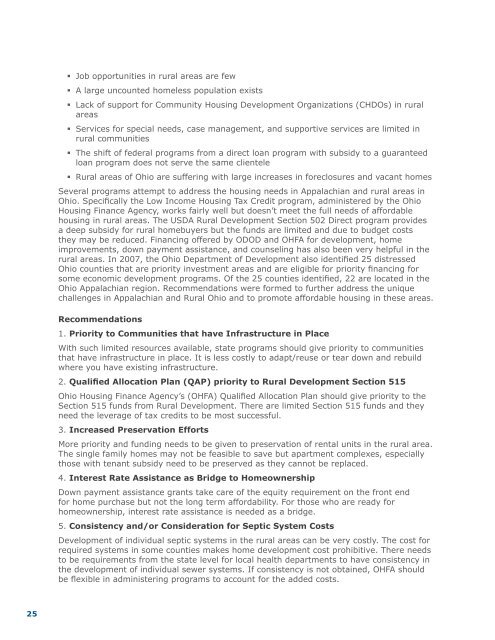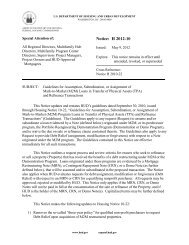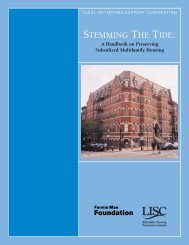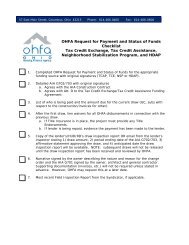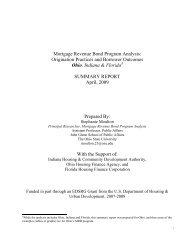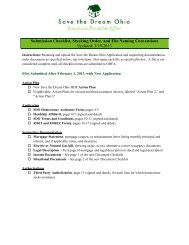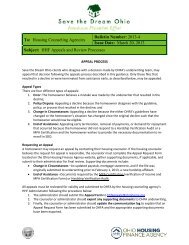OHFA Annual Plan - Ohio Housing Finance Agency
OHFA Annual Plan - Ohio Housing Finance Agency
OHFA Annual Plan - Ohio Housing Finance Agency
Create successful ePaper yourself
Turn your PDF publications into a flip-book with our unique Google optimized e-Paper software.
• Job opportunities in rural areas are few• A large uncounted homeless population exists• Lack of support for Community <strong>Housing</strong> Development Organizations (CHDOs) in ruralareas• Services for special needs, case management, and supportive services are limited inrural communities• The shift of federal programs from a direct loan program with subsidy to a guaranteedloan program does not serve the same clientele• Rural areas of <strong>Ohio</strong> are suffering with large increases in foreclosures and vacant homesSeveral programs attempt to address the housing needs in Appalachian and rural areas in<strong>Ohio</strong>. Specifically the Low Income <strong>Housing</strong> Tax Credit program, administered by the <strong>Ohio</strong><strong>Housing</strong> <strong>Finance</strong> <strong>Agency</strong>, works fairly well but doesn’t meet the full needs of affordablehousing in rural areas. The USDA Rural Development Section 502 Direct program providesa deep subsidy for rural homebuyers but the funds are limited and due to budget coststhey may be reduced. Financing offered by ODOD and <strong>OHFA</strong> for development, homeimprovements, down payment assistance, and counseling has also been very helpful in therural areas. In 2007, the <strong>Ohio</strong> Department of Development also identified 25 distressed<strong>Ohio</strong> counties that are priority investment areas and are eligible for priority financing forsome economic development programs. Of the 25 counties identified, 22 are located in the<strong>Ohio</strong> Appalachian region. Recommendations were formed to further address the uniquechallenges in Appalachian and Rural <strong>Ohio</strong> and to promote affordable housing in these areas.Recommendations1. Priority to Communities that have Infrastructure in PlaceWith such limited resources available, state programs should give priority to communitiesthat have infrastructure in place. It is less costly to adapt/reuse or tear down and rebuildwhere you have existing infrastructure.2. Qualified Allocation <strong>Plan</strong> (QAP) priority to Rural Development Section 515<strong>Ohio</strong> <strong>Housing</strong> <strong>Finance</strong> <strong>Agency</strong>’s (<strong>OHFA</strong>) Qualified Allocation <strong>Plan</strong> should give priority to theSection 515 funds from Rural Development. There are limited Section 515 funds and theyneed the leverage of tax credits to be most successful.3. Increased Preservation EffortsMore priority and funding needs to be given to preservation of rental units in the rural area.The single family homes may not be feasible to save but apartment complexes, especiallythose with tenant subsidy need to be preserved as they cannot be replaced.4. Interest Rate Assistance as Bridge to HomeownershipDown payment assistance grants take care of the equity requirement on the front endfor home purchase but not the long term affordability. For those who are ready forhomeownership, interest rate assistance is needed as a bridge.5. Consistency and/or Consideration for Septic System CostsDevelopment of individual septic systems in the rural areas can be very costly. The cost forrequired systems in some counties makes home development cost prohibitive. There needsto be requirements from the state level for local health departments to have consistency inthe development of individual sewer systems. If consistency is not obtained, <strong>OHFA</strong> shouldbe flexible in administering programs to account for the added costs.25


